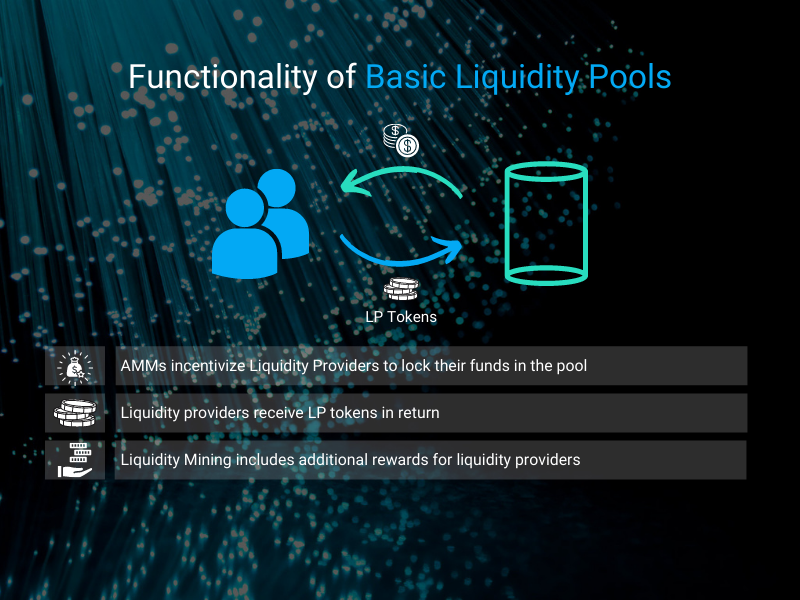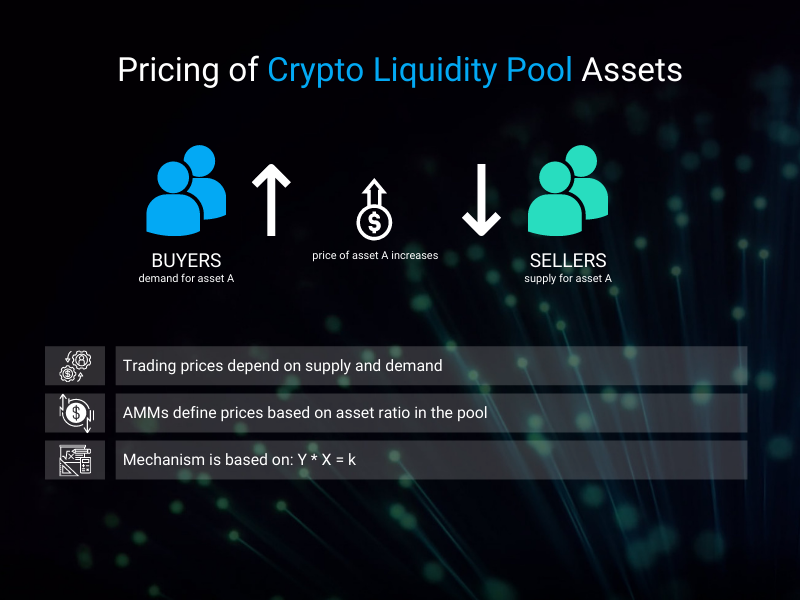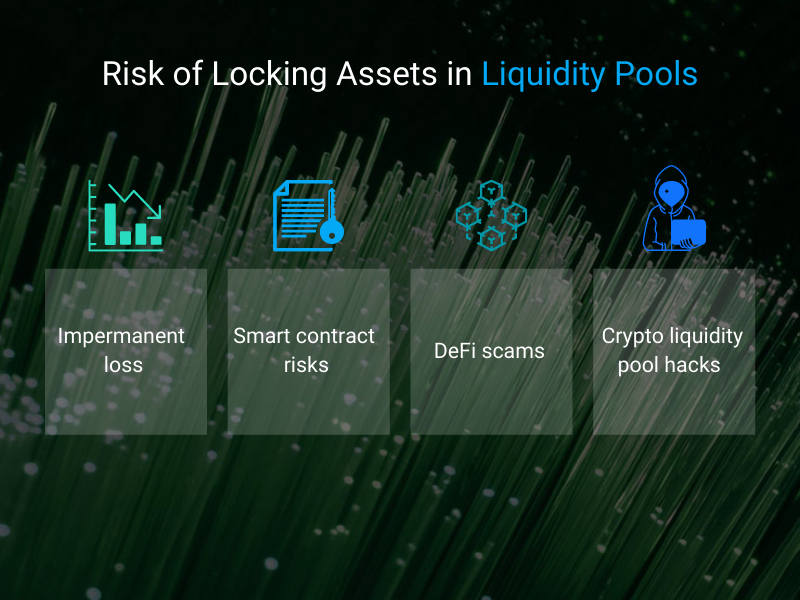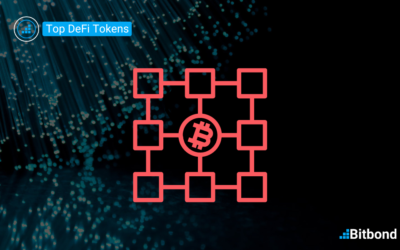Table of Contents
Understanding Crypto Liquidity Pools
In the decentralized finance (DeFi) realm, crypto liquidity pools have emerged as a cornerstone technology, enabling seamless and efficient trading of cryptocurrencies on decentralized exchanges (DEXs). These pools serve as decentralized repositories of crypto assets, managed by smart contracts that automate asset pricing and facilitate transactions without the need for intermediaries.
Crypto liquidity pools are crowdsourced funds of crypto coins and tokens locked in a smart contract. Liquidity pools primarily serve to facilitate automated and permissionless trading between crypto currencies and tokens on decentralized exchanges (DEX). Decentralized exchanges allow users to swap one cryptocurrency for another by executing a trade against a liquidity pool.
Basic liquidity pools are two-sided and therefore lock two different types of crypto coins. To provide liquidity to a basic pool on decentralized exchanges (DEX), liquidity providers (LP) must add an equal value of both coins to the pool. In return for locking their funds, liquidity providers receive LP tokens proportional to their share of the liquidity pool.
Difference between crypto liquidity pools and traditional solutions
Crypto liquidity pools play an essential role in the Decentralized Finance (DeFi) ecosystem as they solve the problem of limited liquidity on decentralized exchanges. Without liquidity pools, traders face huge downside risks and high slippage which makes trading on exchanges inefficient.
Centralized exchanges are based on order book management systems to coordinate trades and guarantee instant transactions. However, implementing a traditional order book management system in decentralized finance systems results in slow transactions and poor user experience. As on-chain transactions require gas fees for interaction, updating orders would be incredibly expensive.
Ethereum, for example, is limited to processing 12-15 transactions per second, therefore, it is nearly impossible to transfer order system managers to decentralized solutions. To solve this issue, decentralized exchanges developed crypto liquidity pools. Thus, liquidity pools are the gateway to offering efficient on-chain solutions for exchanging crypto currencies and tokens. Layer 2 technologies are another means to solve Ethereum’s scalability issues.
Understanding the functionality of basic crypto liquidity pools
At the heart of crypto liquidity pools lies the concept of constant product market makers (CPMMs). These algorithms maintain a balanced ratio between the assets in the pool, ensuring reliable pricing and minimizing slippage, a measure of price deviation during trades.
Basic liquidity pools typically involve two assets, with liquidity providers (LPs) locking equal values of both assets into the pool. In exchange for this service, LPs receive rewards in the form of trading fees and governance tokens. These tokens grant voting rights on pool-related decisions.

Asset pricing in crypto liquidity pools
Unlike traditional centralized exchanges that rely on order books, crypto liquidity pools employ a decentralized approach to asset pricing. The CPMM algorithm governs the pool’s valuation based on the ratio of the assets held within. To maintain a stable price, the algorithm adjusts the number of each asset in the pool according to demand. For instance, if there’s a surge in demand for one asset, the pool automatically adjusts its ratio, ensuring that the price remains consistent.
Decentralized exchanges like Uniswap commonly use the basic equation x*y=k to ensure efficient trading. Both, x and y represent one of the pool’s assets and k is a constant. Consequently, multiplying the price of asset x and asset y must always equal the same number.
Since the price of asset x multiplied by the price of asset y must equal k, a large deposition of asset x to the pool must result in a price increase of asset y. If a large number of coin x is added to the pool in exchange for asset y, supply of asset y is shorted. Thus, trading asset y in return for asset x will be more expensive after the large deposition.
Large pools have a lower risk of slippage as they can accommodate bigger transactions without great changes in prices. DeFi exchanges therefore incentivize liquidity providers to lock more tokens in crypto liquidity pools.

Incentivizing participation in crypto liquidity pools
Instead of relying on buyer and seller matching for transactions, crypto liquidity pools are based on automated market makers (AMMs). Automated market makers are autonomous trading mechanisms that incentivize users to contribute liquidity to the pool in return for a share of trading fees and liquidity provider tokens (LPs).
Liquidity providers must provide an equal value of both coins to the respective pool in order to realize their rewards. As an equal value of both crypto currencies is added, the liquidity pool’s composition is not changed. Thus, liquidity provisions do not influence the rates at which the coins in the pool can be traded.
In return for depositing their funds into the smart contract, liquidity providers receive a percentage of future trade fees and LP tokens. Hence, trading fees of future transactions involving the pool, are split between all liquidity providers. Additionally, governance tokens can be issued, granting liquidity providers voting rights for decisions concerning the pool.
The share of trading fees that liquidity providers receive depends on the number of LP tokens that they hold. LP tokens are handed to liquidity providers in proportion to the amount of coins that they have locked in the pool’s smart contract. To exit a crypto liquidity pool, providers can claim their asset contribution by burning their LP tokens. After burning their LP tokens, liquidity providers lose their right to earn shares of the pool’s trading fees.
To encourage LPs to contribute their assets to liquidity pools, DeFi exchanges offer various incentives. These include:
- Trading Fees: LPs receive a percentage of the trading fees generated from transactions within the pool.
- Governance Tokens: LPs gain voting rights on pool-related decisions by holding governance tokens.
- Yield Farming: LPs can earn additional rewards by participating in yield farming programs that incentivize them to lock their assets in specific pools.
Yield Farming and Crypto Liquidity Pools
Yield farming allows additional incentivization methods to motivate liquidity providers to lock tokens in smart contracts of particular “incentivized pools”. As liquidity providers usually distribute their funds to liquidity pools with the highest yield, DeFi exchanges can control liquidity provision to some extent.
To maintain consistent liquidity in pools and therefore securing reliable trading, liquidity mining is facilitated. Liquidity mining includes the distribution of additional tokens or incentivizing liquidity providers through higher trading fees. Additional rewards serve as a compensation for the additional risk liquidity providers may have to deal with.
Different DEX Protocols: A Variety of Algorithmic Approaches
While basic liquidity pools form the foundation of DeFi trading, various DEX protocols employ distinct algorithms to cater to different needs.
Curve, for instance, focuses on stablecoins, offering enhanced performance and lower slippage for asset pairs with similar prices. Balancer, on the other hand, allows for up to eight assets in a single pool, expanding the range of potential trading pairs.
Addressing the Risks of Crypto Liquidity Pools
Risks associated with crypto liquidity pools include impermanent loss, smart contract risks, DeFi scams and liquidity pool hacks. Impermanent losses commonly occur when the price ratio of the assets in the pool fluctuates. If the pool price is lower than the real-world value of the asset, liquidity providers suffer from arbitrageurs resulting in a temporary loss for liquidity providers.
Impermanent losses only become permanent when liquidity is claimed and taken out of the pool before the price ratio reverts. If liquidity providers continue to lock their assets in the pool, the price ratio may revert and the initial book loss is balanced out. Even though impermanent losses may reduce the value of liquidity providers’ funds, they often continue to provide liquidity as earnings from transaction fees potentially exceed realized losses.
In addition, smart contract risks, DeFi scams and liquidity pool hacks must be considered before providing liquidity to a pool. As the contract of the crypto liquidity pool is practically the custodian of your funds, smart contract bugs may lead to permanent fund losses. Likewise, DeFi scams are projects where developers have privileged access within the smart contracts code enabling them to control some funds.

While crypto liquidity pools offer significant benefits, they also come with inherent risks:
- Impermanent Loss: This occurs when the price ratio of the assets in the pool fluctuates, leading to temporary losses for LPs. However, these losses are typically offset by trading fees.
- Smart Contract Risks: Smart contract vulnerabilities can lead to permanent losses if funds are mishandled. Carefully audit smart contracts before providing liquidity.
- DeFi Scams and Pool Hacks: Exercise caution when selecting pools, as malicious actors may target poorly audited contracts.
Key Takeaways
Crypto liquidity pools are a core technology of the fastest growing crypto sector and therefore shaping further DeFi advancements. As automated market makers allow decentralized trading, they support the trend towards eliminating central authorities from transactions. Liquidity pools are the gateway to offering on-chain trading services and thus highly important when it comes to future DeFi developments.




